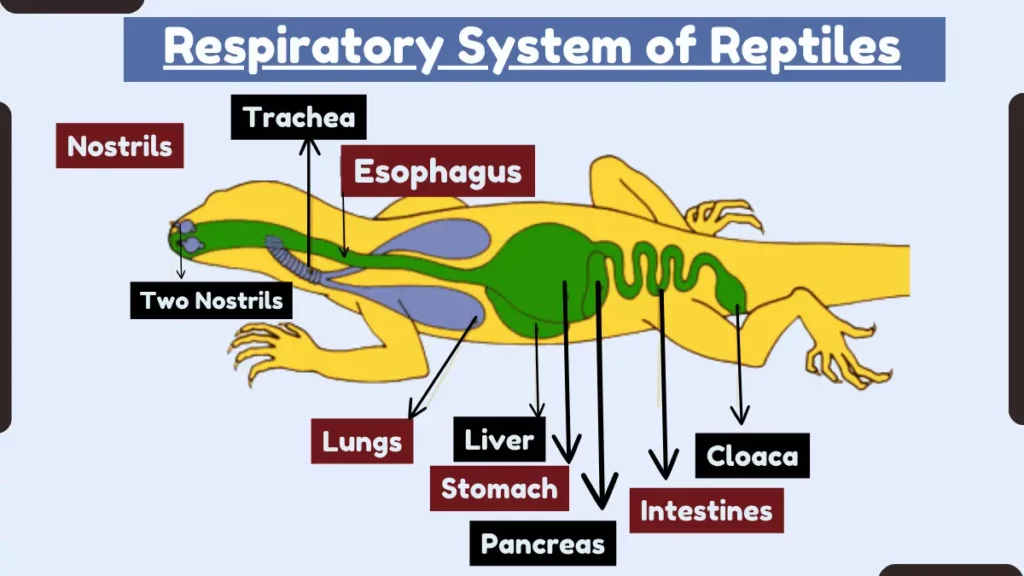Respiratory System of Reptiles– Organs, Adaptations, and Operating Mechanism
Reptiles are the first vertebrates to fully adapt to terrestrial life. The respiratory system of reptiles is relatively simple, but it is very effective. The main organs involved in reptilian respiration are the nostrils, nasal and oral cavities, larynx, trachea, lungs, and air sacs.
One of the key adaptations that made this possible is the development of a respiratory system that allows them to breathe air.

Read about Taste Buds/Gustation in Reptiles
Respiratory organs in Reptiles
Here are a few organs that are involved in the respiratory system of reptiles:
1. Nostrils
The nostrils are the external openings of the respiratory system. They allow air to enter the nasal cavity.
2. Nasal and Oral Cavities
The nasal and oral cavities are passageways for air leading to the trachea. The nasal cavity moistens and warms incoming air, while the oral cavity contains the tongue and teeth.
3. Larynx
The larynx is a cartilaginous structure that contains the vocal cords. It is responsible for producing sound in reptiles (except for snakes, which do not have a larynx). The larynx also helps to prevent food from entering the trachea during swallowing.
4. Trachea
The trachea is a tube that extends from the larynx down to the lungs. It is lined with cilia, which are hair-like structures that help to remove dust and other particles from the air.
5. Lungs
The lungs are the main organs of gas exchange in reptiles. They are spongy, sac-like organs that are located in the thoracic cavity. The lungs are surrounded by the ribcage and diaphragm, which help to protect them and move air in and out of the lungs.
6. Air Sacs
Air sacs are thin-walled pouches that extend from the lungs. They help to increase the surface area of the lungs, which allows for more efficient gas exchange. Air sacs also play a role in temperature regulation and vocalization.
How the Reptilian Respiratory System Works?
Breathing in reptiles is powered by muscles attached to the ribs and spine. When these muscles contract, they expand the chest cavity, which causes air to rush into the lungs. When the muscles relax, the chest cavity decreases in volume, which forces air out of the lungs.
Gas exchange occurs in the thin, moist walls of the lungs. Oxygen diffuses from inhaled air into blood while carbon dioxide diffuses out of blood into the lungs. The oxygen-rich blood is then carried to the rest of the body by the circulatory system.
Adaptations for Different Environments
Reptiles have evolved a variety of adaptations to their respiratory system to allow them to live in different environments. For example, aquatic reptiles like turtles and crocodiles can absorb oxygen through their skin and mouth lining when underwater. This allows them to stay submerged for long periods of time.
Terrestrial reptiles rely on their lungs and air sacs to maximize gas exchange on land. Some terrestrial reptiles, such as lizards and snakes, can also inflate their lungs to help them thermoregulate.
Arboreal reptiles, such as chameleons and tree snakes, have longer, bigger lungs to aid breathing at high altitudes. This is because the air at high altitudes has less oxygen than the air at lower altitudes.
Fossorial reptiles, such as snakes and burrowing lizards, have elongated right lungs to fit their slender shape. This allows them to breathe more efficiently while moving through narrow tunnels and burrows.
The respiratory system of reptiles is a complex and well-adapted system that allows them to breathe efficiently in a variety of environments. This system is essential for their active lifestyle and high metabolic rate.
Also Read:
| Respiratory System of Reptiles | Respiratory System of Birds | Respiratory System of Mammals |
| Circulatory System | Urinary System | Endocrine System |
| Respiration In Cockroach | Circulatory System of Pig |

 written by
written by 

Leave a Reply